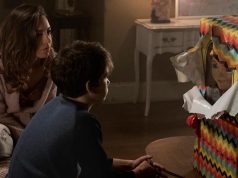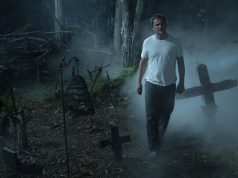Most remakes are unnecessary, but “The Hills Have Eyes” seems especially so. The plot remains virtually unchanged. The only update is that the characters have non-functioning cell phones now. If Wes Craven wants a whole new generation to appreciate his 1977 gorefest, why not just re-release it? It’s not like he’s got any big names in the remake to bring crowds in.
Craven is a producer on the remake, with Alexandre Aja and Gregory Levasseur adapting the screenplay and Aja directing. This is the same duo behind last year’s “High Tension,” the French horror flick that was half-decent until its “twist” ending that didn’t make any sense.
No twists in “The Hills Have Eyes,” don’t worry. Even without having seen the original, you can get a strong sense for who will live and who will die, and when the deaths will occur.
The all-American Carter family is traveling with an Airstream trailer through the New Mexico desert on the way to California when a shifty redneck gas station attendant (Tom Bower) — standard in these films — leads them off the beaten path and into the clutches of a coven of deformed hillbillies. These people are the result of 1940s and ’50s nuclear testing, and for some reason, they’re big fans of torturing, killing and even eating regular folk like the Carters.
What Aja does well — maybe too well, for reasons I’ll explain in a moment — is make us feel some affinity for the characters. Bob (Ted Levine) and Ethel (Kathleen Quinlan) are a likable middle-aged couple celebrating their 25th wedding anniversary. Their teenage son Bobby (Dan Byrd) seems normal enough, their daughter Brenda (Emilie de Ravin) is beautiful and kindly, and their other daughter Lynne (Vinessa Shaw) has recently married a decent man named Doug (Aaron Stanford). Lynne and Doug have a baby daughter. Heck, the Carters even have two fine-looking German shepherds, Beauty and Beast, along for the trip.
The interaction among the characters — Bob and his son-in-law’s philosophical differences, Bobby and Brenda’s hassling of one another, Ethel’s endearing matronly cluelessness (“What’s ‘chronic’?”) — feels realistic. Which makes it all the more upsetting when they are ambushed out in the desert and some of them start dying.
The mutants are relentless in their pursuits, operating with savage, well-organized brutality against the family. The special-effects makeup renders them ghastly (but believable!) in their appearance. Just waking up to find one of them leering over you would be terrifying enough. Imagine if he then tried to rape you and steal your baby.
The appeal of these movies is that they depress you with a feeling of horror and loss, only to revive you with a cathartic finale in which the evil-doers are punished and the embattled heroes emerge victorious. The reason some of these movies fail (“The Devil’s Rejects” comes to mind) is that they emphasize the lows and omit the highs. They’re all terror with no relief.
“The Hills Have Eyes” makes its low points devastating. We feel true grief for the dead characters and the anguish of the survivors. But the revenge — this is really a revenge picture, after all — isn’t sweet enough, in my opinion. Yeah, those murdering monsters from the hills get what’s coming to them, but not in ways that are sufficiently painful or violent enough to be satisfying.
One of the reasons people like intense, blood-soaked thrillers such as this one is that they often demonstrate creativity in the way they devise their scenarios or dispatch their victims. (The “Final Destination” series makes that its focal point.) Others keep the deaths themselves fairly basic but enliven the action with snappy dialogue or darkly comic situations (or, let’s be honest, with gratuitous nudity). “The Hills Have Eyes” has none of that (or of that). It has a no-nonsense agenda: Terrorize the family, kill some of them, and let the survivors get their revenge. But at some point, it stops being fun and just becomes grueling.
C (1 hr., 47 min.; )





